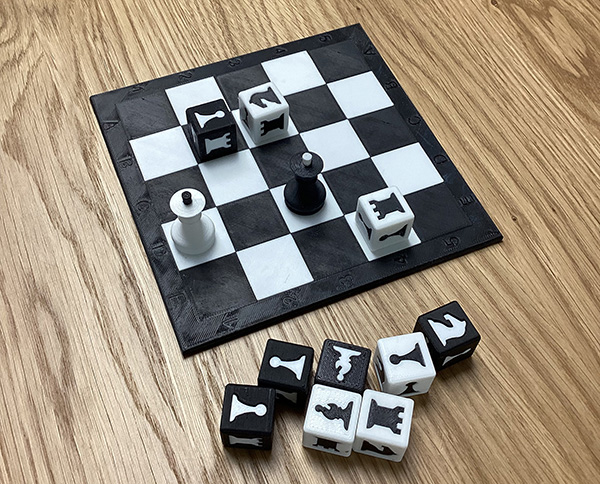Fluky Chess
Fluky Chess is a fast-paced tactical mini-chess variant with the addition of randomness. The game uses special pieces - dice with pawn, knight, bishop and rook symbols. After each move, the player throws the die to determine, what the moved piece going to be on the next move. Thus, the situation on board can drastically change in a couple of seconds. The game was designed to be friendly to less experienced players and give them an opportunity to have fun while learning chess fundamentals. The game size and initial setup were inspired by classic mini chess variants - especially, microchess, and the idea came from my experience as a FIDE School Instructor.
Invented and designed by Ilya Yudovski, 2023
Setup
Initial setup:
The game is played by two people on the 5x5 mini chess board.
At the start of the game, every player has six pieces: a king and five dice pieces with pawn, knight, bishop and rook symbols. The initial setup is as follows:


Pieces
The game uses two kings (black and white) and five dice for each player. The dice are six-sided, depicting three pawns, knight, bishop and rook.
King: moves 1 step in eight directions on a not-attacked square. The King is in check if it is attacked by one or several enemy pieces. It is forbidden to play a move letting his King in check. There is no castling.

The die piece is a cube with three pawns, one knight, one bishop and one rook depicted on its sides. During the game, the player moves it according to the piece depicted on the upper side (top):
Rook moves to any square along the file or the rank on which it stands (identical to standard chess).
Bishop moves to any square along a diagonal on which it stands (identical to standard chess).
Knight jumps to the opposite square of a 2x3 rectangle, no matter what the intermediate square contains (identical to standard chess).
The pawn can move one square forward from its starting position on the board, without capturing. It captures one square diagonally forward. There is no initial two-square move nor en passant.


Rules
The dice pieces are played as chess pieces. At the start of the game, all the dice pieces are played as pawns and should be placed on the board with the pawn symbol on the upper side.
The rules of chess apply, with the following differences:
Each time the die piece is played, the player declares the move, pointing to where the die will move to, or by moving it on the board. Afterwards, the player rolls the die to determine if it's going to be played as a pawn, knight, bishop or rook on the next move. The roll is obligatory, with three exceptions: if the moved piece puts the enemy king in check, the piece reaches the last line as rook, bishop or knight, or if a pawn reaches the last line. In the latter case, the player determines if the piece going to be a knight, bishop or rook, as in regular chess promotion.
Pawns have no double-move option. There is no castling.
The draw and victory conditions:
The victory conditions are to checkmate the other player’s king or to bring your king piece on the other player’s king starting square.
Stalemate (if the player on turn cannot make a valid move, but is not in check) is a draw.
The Threefold repetition rule as in chess applies - when the exact same position occurs the third time on the board with the same player moving with the same options any player can claim a draw without the opponent's consent.
Notes
The game equipment is 3D printed, although a custom 5x5 board and kings from any chess set could be used.
Downloadable king and die files for self-print.
Printable 5 x 5 board JPG file


 This 'user submitted' page is a collaboration between the posting user and the Chess Variant Pages. Registered contributors to the Chess Variant Pages have the ability to post their own works, subject to review and editing by the Chess Variant Pages Editorial Staff.
This 'user submitted' page is a collaboration between the posting user and the Chess Variant Pages. Registered contributors to the Chess Variant Pages have the ability to post their own works, subject to review and editing by the Chess Variant Pages Editorial Staff.
By Ilya Yudovski.
Last revised by Ilya Yudovski.
Web page created: 2023-10-07. Web page last updated: 2024-01-21